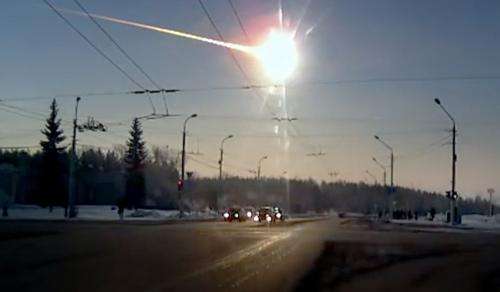Chelyabinsk fireball recorded by a dashcam from Kamensk-Uralsky north of Chelyabinsk where it was still dawn.
Two years after a 20-meter rock slammed into the Earth after a meteoroid dramatically fragmented in the atmosphere over the Chelyabinsk region in Russia and injured hundreds of people, its parent asteroid remains elusive, a new paper published in the journal Icarus shows.
Astronomers had originally predicted that a 2-km near-Earth asteroid (NEA) designated (86039) 1999 NC43 could be the source body from which the Chelyabinsk meteoroid was ejected prior to its encounter with the Earth.
"These two bodies shared similar orbits around the Sun, and initial studies suggested even similar compositions," said Planetary Science Institute research scientist Vishnu Reddy, lead author of "Link Between the Potentially Hazardous Asteroid (86039) 1999 NC43 and the Chelyabinsk Meteoroid Tenuous" that appears in Icarus.
However, reanalysis of the orbital parameters and spectral data by an international team of researchers led by Reddy has shown that the link between Chelyabinsk and 1999 NC43 is unlikely. "The composition of Chelyabinsk meteorite that was recovered after the event is similar to a common type of meteorite called LL chondrites. However, the near-Earth asteroid has a composition that is distinctly different from this," Reddy said.
They study also showed that linking specific meteorites to an asteroid is extremely difficult due to the chaotic nature of the orbits of these bodies.
More information: "Link Between the Potentially Hazardous Asteroid (86039) 1999 NC43 and the Chelyabinsk Meteoroid Tenuous," Vishnu Reddy et al., Icarus, Volume 252, 15 May 2015. Visit www.psi.edu/news/reddypaper to see the paper.
Journal information: Icarus
Provided by Planetary Science Institute






















